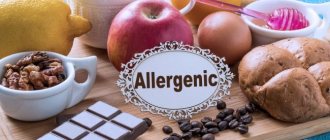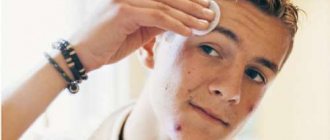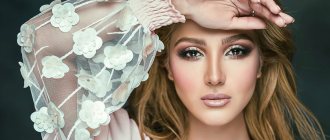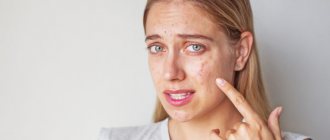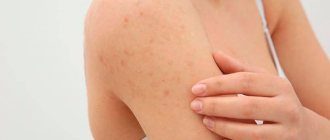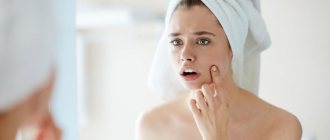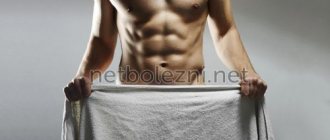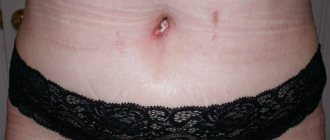From this article you will learn:
- why do acne appear on the chin, forehead or cheeks,
- reasons for their development in women,
- the most effective remedies for acne on the face,
- use of phototherapy (IPL) and laser.
The article was written by a specialist with higher medical education.
Pimples on the face are inflammatory formations on the skin, which are a consequence of the formation of acne (open and closed comedones) in the hair follicles and their subsequent infection. There are 2 types of acne - the so-called “papules” and “pustules”. Papules look like inflamed bumps on the skin, but they do not contain pus inside. Pustules are classic pimples in which a blister of pus has already formed.
Papules can be independent formations and, persisting for up to 2 months, can then disappear without a trace. However, most often papules turn into pustules. In general, the term “acne” is a colloquial expression, and it is correct to call this disease papulopustular acne. This form is usually preceded by the comedonal form of acne, which is nothing more than acne. The formation of blackheads (sebaceous plugs) in the hair follicles is a necessary basis for the subsequent formation of acne.
Types of acne on the face in teenagers (papules) -
Pimples in the form of pustules -
Pustules and papules are superficial inflammatory elements. Pustules go through their full development cycle in an average of 10-12 days, and after they disappear, a bright hyperpigmented spot remains in their place. As we said above, papules can persist from 10 days to 2 months, and they can either turn into pustules or disappear without a trace (or rather, weakly pigmented spots remain in their place). You probably already realized that it is useless to squeeze out papules, and this can only lead to increased inflammation and suppuration.
Getting rid of acne on your face if you have mild acne (moderate amount of superficial inflammatory elements) is not very difficult. However, in a number of patients, deep inflammatory elements can also form - these include the so-called indurative, abscessing, phlegmonous, draining, and conglobate acne. After the disappearance of such inflammatory elements, superficial or deep atrophic scars remain in their place, less often keloid scars.
The most common location of acne is if we talk about the face, then most often acne appears on the forehead, as well as acne on the chin. No less common localization are pimples on the cheeks or in the area of the ears. Some patients may experience acne on the scalp (in the scalp), as well as in the back and shoulders. This localization is due to the fact that it is in these areas that the skin contains the maximum number of sebaceous glands - about 400 to 800 per 1 cm2.
Acne on the face in teenagers: causes
We have already said above that it all starts with the comedonal form of acne, i.e. since the appearance of acne. The main reason for the formation of acne in adolescence is an increase in the production of androgens during puberty (puberty). The main androgen in girls is androstenedione, and in boys it is testosterone. Puberty for girls begins at approximately 12-13 years of age, for boys at 14-15 years of age. It is during this period that approximately 85% of adolescents experience the first manifestations of the comedonal form of acne (acne).
Let us remember that the main elements of acne are comedones (white or blackheads), which are non-inflammatory formations. In the middle and late teenage period, against the background of comedones, inflammatory elements (papules and pustules) already begin to predominate, which will indicate the transformation of the comedonal form of acne into the papulopustular form. The course of mild forms of acne usually lasts no more than 4-5 years, but the course of moderate-severe forms can last even 10-12 or more years.
The most striking clinical picture of acne (blackheads and pimples) is observed in girls between the ages of 17 and 18, and in boys between the ages of 19 and 21. It should be noted that girls are less fortunate and are characterized by a longer course of acne, which is also due to the presence of the menstrual cycle. In particular, it is known that in the period from 2 to 7 days after ovulation, acne symptoms intensify in girls. This is due to an increase in the concentration of luteinizing hormone during this period, and the conversion of androstenedione (this is the main androgen secreted by the ovaries) into testosterone.
Important: let's look at how androgens are associated with the appearance of acne and pimples... The fact is that the sebaceous glands have receptors for androgens, and therefore an increased concentration of the latter automatically leads to hyperactivity of the sebaceous glands. As a result, they begin to produce too much sebum, which contributes to the formation of fatty plugs in the lumen of the hair follicles, which are called acne or comedones.
Features of therapy
If treatment of the pathology has just begun, it is recommended to first use local remedies. For example, creams, ointments, tonics, masks, lotions. They act only locally, so the risk of side effects is reduced. With their help, you can provide high-quality care, during which excessive sebum production and clogging of pores are eliminated.
If pimples arise due to systemic abnormalities, local remedies will not be enough, so you will need to use medications in conjunction with diet correction, the correct regimen and other methods.
Oral medications should only be prescribed by a doctor. They have side effects, contraindications, and can cause an overdose. Therefore, the purpose of therapy is determined by a cosmetologist, dermatologist, or therapist.
To eliminate acne, tests and a general examination are performed. With their help, the need for the use of the following drugs is identified:
- antibacterial agents;
- hormones;
- retinoids;
- sorbents;
- multivitamins.
The listed therapy methods can be used alone or combined with each other. It all depends on the cause of acne formation.
Pimples on the forehead or chin in women: causes
Why do acne form on the chin in women? The reasons here may also be hidden in hormonal background. The fact is that increased concentrations of androgens can occur not only in adolescents. Clinical studies show that 30% of women with acne have laboratory confirmed absolute hyperandrogenism, i.e. increased production of androgens of ovarian or adrenal origin.
Acne in middle-aged women is most often localized in the chin and cheeks; sometimes women also experience acne on the forehead:
We have already said above that in women, in the period from 2 to 7 days after ovulation, current symptoms of acne may arise or intensify. This is due to peak concentrations of luteinizing hormone, which promotes the transformation of androstenedione into testosterone, and the latter, thanks to enzymes, is already converted into dihydrotestosterone. Therefore, taking into account all the above-mentioned causes of acne in women, a remedy for acne on the face, such as oral contraceptives or antiandrogens, can be used as part of complex therapy.
Another cause of acne in women may be the use of oral contraceptives based on pure progesterone. This is due to the fact that sebocytes (these are the cells of the sebaceous glands that produce fatty secretions) have receptors not only for androgens, but also for progesterone. However, the largest group of adult acne patients (both women and men) do not have an increase in androgen production, but they still have overactive sebaceous glands. What this is connected with - read below.
Other causes of acne in adults -
As we said above, the sebaceous glands have receptors for androgens. The fact is that hyperactivity of the sebaceous glands can occur even with normal concentrations of androgens (if these receptors, due to genetics, have increased sensitivity to androgens). The receptors become more sensitive to androgens due to increased activity of the following enzymes: 17-β GSD, 3-β GSD, and 5 α-reductase. The first 2 enzymes convert dehydroepiandrosterone and androstenedione into free testosterone, and 5 α-reductase further converts testosterone into dihydrotestosterone (24stoma.ru).
In general, it is precisely due to the increased activity of these enzymes that in men and women there is an increase in the concentration of dihydrotestosterone (even if the level of androgens is normal). It is dihydrotestosterone that is the main and direct hormonal stimulator of the activity of the sebaceous glands. Studies have shown that in patients with acne and pimples, the synthesis of dihydrotestosterone in the sebaceous glands is increased from 2 to 30 times - compared to patients without acne symptoms. And, by the way, one of the markers of increased activity of these enzymes is the presence of androgenic alopecia in the patient (which occurs not only in men).
Juniper from Mi&Ko
Acne cream perfectly fights acne and other imperfections of problem skin. “Juniper” can be applied not only to the face, but also to other areas of the body where there are rashes. Use the cream morning and evening. The drug relieves inflammation and destroys bacteria, nourishes the skin, moisturizes, and reduces sebum production. Juniper cream is suitable for both teenagers and those who have pimples and acne due to hormonal imbalances or with age. According to customer reviews, the cream smells nice, has a comfortable texture, is not tested on animals and is inexpensive.
Types of skin rashes
Photos from open sources
Juniper from Mi&Ko cream
MiKo, Russia
Face cream Juniper consists of 24% organic raw materials. The new formula contains lavender hydrolate and boswellia extract, which instantly improve complexion, eliminate dryness and inflammation, and protect the skin from stress. A unique extract of wintergreen leaves eliminates rashes and stimulates skin renewal. With Juniper cream, your skin will be healthy and smooth, which will be the key to self-confidence!
39
- Like
- Write a review
Key Factors in Acne Formation –
You probably already realized that overproduction of sebaceous gland secretions is one of the main reasons why acne appears on the face. But this factor is far from the only one. This also includes the process of follicular hyperkeratosis, and in addition, the bacteria Propionibacterium acne (P.acne), which live both on the surface of the skin and subsequently in the ducts of the sebaceous glands, are also important.
- Hyperproduction of sebaceous gland secretions – it is caused by increased production of androgens, as well as increased sensitivity of sebaceous gland receptors to androgens. We have already described this process above, but as it turned out, what is important here is not only that there is an increase in the secretion production of the sebaceous glands. A very important point is the change in the chemical composition of the secretion of the sebaceous glands (sebum). In particular, against the background of increased secretion, there is a decrease in the content of linoleic acid in the sebum.
The function of the latter is to regulate the processes of differentiation and desquamation of follicular and epidermal keratinocytes. The stratum corneum of the epidermis of the skin consists of epidermal keratinocytes, and follicular keratinocytes line the lumen of the hair follicle. A decrease in the content of linoleic acid in sebum causes follicular hyperkeratosis, which is one of the most important factors in the development of acne and pimples (we will talk about follicular hyperkeratosis below).Simultaneously with the decrease in the concentration of linoleic acid, the content of unsaturated fatty acids in the sebum increases (from 5 to 20%). Such acids are comedogenic and also contribute to the development of follicular hyperkeratosis and the onset of inflammation. And lastly, an increase in sebum secretion also leads to the fact that follicular keratinocytes begin to release an inflammatory mediator called IL-1α (interleukin-1α). This mediator also promotes follicular hyperkeratosis and the development of inflammation.
- Follicular hyperkeratosis - the lumen of the hair follicle is covered with layers of follicular keratinocytes of varying degrees of differentiation.
When their cell layers are renewed, a constant process of exfoliation of their surface layer occurs. A low concentration of linoleic acid in sebum leads to: 1) hyperproliferation of follicular keratinocytes, i.e. to a sharp increase in the number of their layers and their thickness, 2) to a disruption in the desquamation of keratinocytes into the lumen of the hair follicle. Follicular hyperkeratosis, together with an increase in sebum production, leads to the formation of fatty plugs (comedones) in the lumen of the follicles, obstruction of the follicles and the onset of the inflammatory process. Moreover, at the first stage, inflammation is not associated with a sharp increase in the number of P. acne bacteria in the lumen of the follicle and its damage, but is associated with the production of interleukin-1α by follicular keratinocytes, as well as with an increase in the concentration of free fatty acids. - The presence and activity of the bacteria "P. acnes" - the bacterium Propionibacterium acnes (and to a lesser extent Staphylococcus epidermidis) - are the main microorganisms that are involved in the formation of acne.
These bacteria are representatives of the normal opportunistic skin flora, which is also present on the skin of people without acne symptoms. For a long time, the importance of these bacteria was underestimated; for example, it was believed that they were only responsible for the development of local inflammation in the hair follicle. However, this bacterium also affects the formation of comedones (blackheads) themselves. In particular, the increase in the content of free unsaturated fatty acids in sebum occurs precisely thanks to the enzymes (lipases) of these bacteria. These enzymes break down di- and tri-glycerides contained in the secretions of the sebaceous glands into free fatty acids. And as we said above, free fatty acids are comedogenic and contribute to follicular hyperkeratosis and the development of inflammation. In addition, the listed bacteria secrete enzymes, which subsequently lead to rupture of the walls of the hair follicle - as a result of which the entire contents of the follicle are poured into the surrounding tissue, which leads to a pronounced local inflammatory reaction.
What factors can aggravate the appearance of acne -
- use of comedogenic cosmetics,
- insufficient cleansing of the skin from water- and fat-soluble contaminants,
- medications (prednisolone, steroid hormones, drugs with lithium, anticonvulsants, iodides and bromides),
- active sweating.
Antibiotic therapy
Antibiotics are used not only to relieve systemic infections, but also to eliminate inflammatory lesions of the skin caused by the accumulation of pathogenic microflora. Normally, the epidermis always contains opportunistic microflora. But if there is an additional damaging factor, bacteria begin to actively multiply, secrete toxic products, and clog pores. The optimal course of antibiotic therapy is 10 days. If the effect is small, treatment is extended to a maximum of 14 days. But it is important to understand that antibiotics have serious contraindications and side effects.
Attention! If the patient uses antibiotics, it is recommended to additionally use a gentle diet and not drink alcohol, otherwise there will be a burden on the gastrointestinal tract. The medicine may not work.
Erythromycin
A broad-spectrum antibiotic is recommended for use with the following agents:
- gels;
- ointments.
Zinc ointment has a special effect, as it disinfects and additionally dries the skin, reducing the size of acne. Recommendations for the use of erythromycin:
- drink 1 tablet 2 times a day;
- use the maximum course of treatment for 7-10 days;
- It is prohibited to interrupt the course of therapy in order to prevent the bacteria from becoming accustomed to the active substance with the subsequent lack of effect from the treatment.
Side effects:
- vaginal candidiasis;
- digestive disorders.
Contraindications:
- individual intolerance to the components included in the composition;
- severe inflammatory pathologies of the liver;
- children under 9 years old;
- pregnancy, breastfeeding.
If the patient decides to use erythromycin, it is recommended to reduce the amount of dairy products in the diet. Milk negatively affects the active component, slowing down its effect on the body.
Levomycetin
A broad-spectrum antibiotic is intended to treat persistent bacterial infections when pathogenic microorganisms may be resistant to other drug groups. Indications for use:
- small acne with purulent contents;
- acne;
- boils.
Effects:
- anti-inflammatory;
- antibacterial.
Contraindications:
- severe liver and kidney diseases;
- pregnancy, lactation;
- candidiasis;
- individual intolerance.
Side effects include an allergic reaction on the skin and mucous membranes, and impaired stool formation.
Take 3 tablets per day. The optimal course of therapy is selected only by a doctor, and lasts up to 14 days. If the tablet is pre-crushed and added to the mask, it will have both a moisturizing and antibacterial effect, penetrating into the deep layers of the epidermis.
Metronidazole
The drug has a triple effect:
- eliminates acne due to its antibacterial effect;
- heals damaged tissue without leaving scars;
- relieves active inflammatory process.
Contraindications:
- individual intolerance to the components in the composition;
- severe damage to the nervous system and liver;
- bearing a child, breastfeeding.
Side effects:
- allergic reaction;
- headache, dizziness;
- violation of stool formation.
When using the product, the functioning of the endocrine system improves, which helps in eliminating teenage rashes. To do this, it is recommended to take 1 tablet 2 times a day.
Tetracycline
After consuming the drug, the antibiotic spreads through the systemic bloodstream, affecting the elimination of acne from within the body. It destroys germs and helps fight even boils. The drug is taken 250 mg 2 times a day.
Contraindications:
- liver damage;
- spread of fungus;
- pregnant, lactating women.
Side effects:
- prolonged diarrhea with reduced absorption of nutrients into the bloodstream;
- plaque on the teeth, causing an unpleasant odor and damage to the enamel;
- photosensitivity, that is, a negative skin condition under the influence of sunlight.
The drug begins to decompose under the influence of sunlight. Therefore, it is not recommended to store the packaging in a sunny place.
The most effective remedies for acne on the face -
How to remove acne from the face quickly and without complications? The most difficult thing here is to choose the right combination of drugs and draw up a treatment regimen taking into account the specific clinical situation. Below you can see that the approach to treating acne on the face may differ - depending on the predominance of different types of inflammatory elements (papules or pustules), as well as on the severity of the disease. The most effective remedies for acne on the face:
- antibiotics,
- products with benzoyl peroxide,
- topical retinoids,
- oral contraceptives in women,
- phototherapy (IPL), photodynamic therapy and lasers,
- comedones extraction method.
Only a dermatologist or a dermatologist-cosmetologist can professionally treat acne on the face. Unfortunately, in most cases, patients seek consultation with a specialist late, and this leads to complications - the appearance of persistent age spots, as well as superficial atrophic scars. Below you can see a treatment plan for acne, which is based on recommendations from the most famous English-language textbook for dermatologists around the world, Fitzpatrick's Dermatology.
How to get rid of acne on your face (according to Fitzpatrick's Dermatology):
Below we will look at all the types of drugs that are indicated in this scheme, and now you will know for sure which ointment for acne on the face will be the best in your case. Please note that azelaic and salicylic acids are not the main remedy for acne on the face, and can only be used as “second-tier” drugs. You can find out more about them at the link above. At the same link you can learn about the use of oral contraceptives in women.
Antibiotics for acne treatment –
Antibacterial drugs for the treatment of acne can be used both for external use (usually in the form of gels) and in the form of tablets for oral administration. Modern research shows that antibacterial therapy in patients with acne is not very effective, because Over time, it causes the formation of resistant strains of bacteria and, as a result, leads to more severe acne. But in some cases, antibiotic therapy for acne is still necessary, and in addition, there are ways to reduce the risk of bacterial resistance to antibiotics.
a) Mild to moderate papulopustular acne:
Antibiotics, if prescribed, are only externally. These may be drugs such as Dalacin, Clindovit or Clindatop. These drugs are monocomponent gels containing the antibiotic clindamycin. In addition, there are drugs in the form of solutions for topical use, for example, the drug Zerkalin. This drug is clindamycin based, but it also contains alcohol, which is actually not very good for acne patients (especially if you are also using retinoids and benzoyl peroxide).
Another drug - Zinerit (in the form of a solution that is applied using an applicator) - is based on erythromycin, but there are now many resistant strains of the bacterium P.acnes to this antibiotic. There are also combination preparations that, in addition to the antibiotic, may additionally contain either the retinoid adapalene or benzoyl peroxide. An example of several combination preparations in the form of gels:
- Klenzit-S – contains clindamycin 1% + adapalene 0.1%,
- Indoxyl – contains clindamycin 1% + benzoyl peroxide 5%.
Photos of some drugs –
Important: for papulopustular acne of mild or moderate severity, antibacterial gels are prescribed primarily only in cases where the predominant inflammatory elements in the patient are pustules with pus. In this case, in addition to the external antibiotic, we must simultaneously use + external retinoids, + benzoyl peroxide.
And here you may ask: why is it recommended to also use benzoyl peroxide when prescribing an antibiotic gel? Isn't one antibiotic enough? The fact is that the use of benzoyl peroxide together with an antibiotic greatly reduces the risk of P.acnes bacteria developing resistance to antibiotics. Including the development of such resistance contributes to the transformation of mild forms of acne into forms with a more severe course.
As for patients whose inflammatory elements are represented predominantly by papules (i.e., without pus), it is irrational to prescribe antibiotics in this case. It is optimal to use only a combination of external preparations “benzoyl peroxide + retinoid”.
b) Papulopustular form of severe acne:
For severe papulopustular acne, antibiotics are prescribed only orally (i.e. in tablets for oral administration), plus we prescribe externally retinoids + benzoyl peroxide. For systemic antibiotic therapy, drugs from the tetracycline group will be primarily used - this can be either tetracycline itself or its derivatives - doxycycline and minocycline. Only a doctor can determine the optimal dosage for each individual patient.
As for tetracycline, the average daily dosage is usually 1000 mg, but in serious cases the dose can be increased to 3500 mg per day (such doses can only be used under monitoring of liver function). Tetracycline can be taken only 1 hour before meals or 2 hours after; the duration of administration is determined by the doctor, but not more than 8 weeks. However, this drug has serious age restrictions, and in recent years more resistant strains of P. acnes have been discovered.
Much fewer resistant P. acnes strains have been found to lipophilic tetracyclines (such as doxycycline and minocycline). Doxycycline is taken at a dose of 100 to 200 mg per day orally for no more than 8 weeks, regardless of meals. However, it induces photosensitivity in the summer and therefore in summer it is better to use another antibiotic (azithromycin). Minocycline is also taken at a dose of 100-200 mg per day, but this drug can cause blue-black pigmentation in different areas of the skin. This pigmentation most often occurs in the area of atrophic scars and acne scars.
A good drug of doxycycline is
Antibiotics of the Macrolide group - previously a drug such as erythromycin was widely used, but now there are a lot of resistant strains of P.acnes to it. It is more preferable to prescribe azithromycin in a dose of 250 to 500 mg (taken only 3 times a week). Unfortunately, this drug may have side effects such as diarrhea, and therefore it is best to take it only with parallel medications to restore intestinal microflora. Azithromycin is a good alternative for patients who cannot use doxycycline.
Antibiotics of the Lincosamide group - clindamycin belongs to this group of antibiotics. But its use is justified only for external therapy (with the composition of products for external use), and when taken orally, there is too high a risk of getting a severe form of anibio-associated diarrhea, which is called pseudomembranous colitis. This is such a terrible thing (with a high mortality rate) that don’t even think about taking clindamycin tablets.
Drugs of the sulfone group - these include the drug Dapsone, but it can only be used if the patient develops resistance to other antibiotics (i.e. this drug will not be the first choice drug). Antibiotic resistance should be suspected if there is no response to treatment after 6 weeks of antibiotics. Moreover, in cases where we assume resistance, it is very important for us to exclude the development of gram-negative folliculitis in the patient (usually it occurs precisely after long-term use of antibiotics in the past).
Important: the most painful area of antibiotic therapy in the treatment of acne is the development of resistant strains of P.acnes and S.epidermidis. Concurrent use of topical benzoyl peroxide products with antibiotics, and avoidance of frequent changes between different antibiotics, are the best ways to prevent antibiotic resistance in P. acnes and S. epidermidis. Phototherapy procedures (IPL), photodynamic therapy, and the use of lasers can help reduce the need for antibiotics. We will tell you more about them at the end of the article.
Preparations with benzoyl peroxide –
Benzoyl peroxide is a bactericidal component and is probably the best remedy for acne (it can even be called the gold standard of therapy). This is a bactericidal component that effectively inhibits the growth of P. acnes bacteria, leading to the development of local inflammation in the area of hair follicles and the appearance of papules and pustules (pimples). It is very important that benzoyl peroxide, unlike antibiotics, does not cause the emergence of antibiotic-resistant microflora.
Professional pharmaceutical preparations with benzoyl peroxide are produced in the form of a gel (usually with a concentration of 2.5 or 5%). For the first month, in order to get the skin accustomed to benzoyl peroxide, it is optimal to use a concentration of 2.5%, and then switch to 5% of the product. If you use more concentrated products at once, irritation will likely appear on the skin. The classic monocomponent preparation with benzoyl peroxide 2.5 or 5% is Baziron-gel.
Combination drugs - but there are drugs where benzoyl peroxide is combined with an antibiotic or retinoid. As you will see below, each of these drugs will be effective in slightly different clinical situations, for example, depending on what type of inflammatory components (papules or pustules) you have. Examples of combination drugs for acne treatment:
- Indoxyl (UK) – benzoyl peroxide 5% + clindamycin 1%.
- Effezel (France) – benzoyl peroxide 2.5% + retinoid adapalene 0.1%.
How to choose the right drugs:
1) For mild to moderate papulopustular acne, the choice depends on the predominance of certain inflammatory elements. If papules predominate (without pus inside), then in this case the combination of “benzoyl peroxide + retinoid” will be optimal. For example, this could be the combination drug Effezel. But for patients with sensitive skin, it is better to use a combination of two monodrugs - benzoyl peroxide in the morning and a retinoid in the evening.
Thus, you can use the drug “Baziron” with benzene peroxide in the morning, and in the evening – one of two drugs “Klenzit” or “Differin” (containing the retinoid adapalene) of your choice. But if you have pustules with pus, then to the above combination of “benzoyl peroxide + retinoid” we also add external use of an antibiotic.
2) For severe papulopustular acne, we also use “benzoyl peroxide + retinoid” for external use, and also add systemic antibacterial therapy. Antibiotics for this form are used only orally, in long courses of up to 6-8 weeks (see above).
Side effects of benzoyl peroxide: Be aware that itching, burning sensation, dryness, tightness, redness, or flaking of the skin may occur after use. But usually these effects are not too pronounced. If you use the drug during active sunny periods, be sure to use sunscreen, because Benzoyl peroxide makes facial skin more sensitive to sunlight.
Skinoren
This cream contains azelaic acid, which helps regulate sebum secretion, fights pathogenic bacteria, and relieves inflammation. “Skinoren” has proven itself well even in advanced stages of acne, although long-term treatment with this remedy is undesirable. Skinoren dries out the skin, so it is better not to use it if you have peeling. Apply the cream morning and evening to the affected areas of the skin and rub in lightly.
Skinoren
Intendis Manufacturing, Italy
Skinoren is a drug for the treatment of acne vulgaris or juvenile acne and hyperpigmentation.
from 349
4.0 1 review
1183
- Like
- Write a review
Topical retinoids (adapalene)
In fact, this is the most important ointment for acne on the face. Topical retinoids are intended for external use. Such drugs are prescribed - 1) for the comedonal form of acne, which means acne, 2) for the papulopustular form of acne (i.e. in the presence of pimples). Previously, the topical retinoid tretinoin was used to treat acne, but it had a lot of side effects, and now there are much safer 4th generation topical retinoids, for example, adapalene.
Such drugs are monocomponent and combined. Monopreparations based on adapalene include Differin, Klenzit or Adaklin. A number of drugs of this type are produced only in the form of gels, but some manufacturers produce drugs with adapalene in both gel and cream form. Gel products will be more effective, but facial acne cream is more suitable for patients with dry and/or sensitive skin (and will help reduce the risk of irritation in such patients).
Examples of combination drugs with retinoids are 1) Klenzit-S, containing adapalene together with the antibiotic clindamycin, 2) Effezel, containing adapalene in combination with benzoyl peroxide. The choice of drug will depend on the severity of the acne, as well as on which inflammatory elements predominate in you (papules or pustules). All this information is schematically reflected in Table 1, which we placed before the description of groups of drugs for the treatment of acne.
How to treat facial acne with retinoids:
- Preparations containing adapalene should be used once a day before bedtime. Before applying a retinoid, you should wash your face with a mild cleanser. Before applying the retinoid, the skin must be completely dry, because... otherwise severe irritation will develop. To get your skin used to it and not be too irritated, start using the drug 3 times a week. After 1-2 weeks, switch to daily use.
When can you expect results: skin oiliness decreases sharply within a few days from the first use. As for acne and pimples, the first noticeable result can be seen only after about 4 weeks of therapy. Good results can be seen after about 8 weeks of using retinoids, but for radical improvement a full course is required, which lasts at least 12 weeks (3 months).
Use of oral retinoids:
In addition to topical retinoids intended for external use, there are also so-called systemic retinoids for oral administration. Such drugs (Acnecutane or Roaccutane) contain the retinoid isotretinoin. These drugs are very effective for treating acne, but they also have very serious side effects. Therefore, such drugs are used only in difficult situations, for example, for the treatment of nodular and conglobate forms of acne.
Use of oral contraceptives in women:
As for the use of oral contraceptives in women, you can read more about this method of treatment in the article at the link below:
→ Oral contraceptives for acne in women
Effaclar Duo + by La Roshe-Posay
Cream-gel is indicated for inflammation of the skin, for mattifying and deep moisturizing, prevention and treatment of acne. Effaclar Duo + contains thermal water (moisturizes the skin), prokerad (fights post-acne), lipo-hydroxy acid salicylic acid (renews epidermal cells, regulates sebum production, lightens spots on the skin). An excellent remedy for treating moderate acne. The instructions say that the positive effect occurs within 12 hours after the first use of the cream-gel. Effaclar Duo + is suitable not only for spot treatment of acne, but also for the entire face. The product has a good texture, is quickly absorbed, dries out rashes, does not leave a greasy sheen or stickiness, and does not tighten pores. Can be used as a base for makeup.
Effaclar Duo+
La Roche-Posay, France
Effaclar DUO(+) against the re-formation of imperfections. Light cream-gel EFFACLAR DUO(+) moisturizes the skin for 24 hours and provides a long-lasting mattifying effect. By adding two new active ingredients - Aqua Posae Filiformis and Mannose - the product restores the skin microbiome, which helps reduce the incidence of inflammation. Efaklar DUO(+) contains Prokerad, which prevents the appearance of residual marks from imperfections (post-acne) in the form of red and dark spots. Is an excellent base for makeup.
48
- Like
- Write a review
Squeezing pimples and blackheads (comedone extraction)
For comedonal and papulopustular forms of acne, invasive methods are sometimes used, for example, comedonal extraction. Extraction means their removal/squeezing out - using special comedones extractor tools, or by palpation. Moreover, we are talking about the removal of macrocomedones, i.e. large eels. But squeezing out pimples (papules and pustules) can, at best, lead to the appearance of a hyperpigmented spot in this area in the future.
In the worst case, self-squeezing pimples and blackheads can lead to the spread of inflammation and the formation of deep subcutaneous pimples, which will leave superficial or deep atrophic scars on the skin. Therefore, only comedones (acne) can be squeezed out, and secondly, this should only be done by a dermatologist or a dermato-cosmetologist. The procedure is called “mechanical facial cleansing.”
Mechanical facial cleansing: video
Important: keep in mind that the removal of comedones is much easier and without complications if the patient has previously used topical retinoids for at least 3-4 weeks. The fact is that topical retinoids (adapalene) also have comedonolytic properties.
Zenerite
One of the most popular remedies for acne and acne, which contains an antibiotic (erythromycin) and zinc salts. Erythromycin prevents the growth of bacteria, and zinc salts work as an antiseptic. If you have been prescribed "Zinerit" for acne, remember that it is not advisable to use it often and for a long time, because addiction develops and the drug simply stops working.
Zenerite
Astellas Pharma Europe, Russia
Zenerite powder for solution preparation (external use), 30 milliliter bottle - a medicinal product for the treatment of acne.
Resistant to cosmetic products. from 533
5.0 1 review
2007
- Like
- Write a review
Phototherapy and lasers for acne treatment
Phototherapy and lasers are used to treat acne - either endogenous porphyrins contained in P. acnes, or sources of exogenous porphyrins are additionally applied to the skin before the procedure. Porphyrins have the property of absorbing light in the blue regions of the spectrum (wavelength 415 nm), which leads to the formation of unstable oxygen and, as a result, to the destruction of pathogenic bacteria P.acnes. The FDA recommends Lumenis devices (for example, the IPL module of the M-22 device), which use high-intensity light from the blue part of the spectrum, for the treatment of papulopustular acne, i.e. acne.
Light from the red part of the spectrum can also be useful because... Compared to blue light, it has a stronger anti-inflammatory effect (although it has a lesser effect on porphyrins). Therefore, a combination of light from the blue and red parts of the spectrum will be even more useful. Facial procedures are carried out 2 times a week for 15 minutes. According to the dermatology textbook Fitzpatrick's Dermatology, after a 4-week course of therapy in 80% of patients, the number of acne decreased by 60%. But in the absence of supporting procedures, their number returns to the original level - within 3-6 months.
Photodynamic therapy is even more effective in treating acne. It consists of applying exogenous porphyrins to the skin 1 hour before the procedure (aminolevulinic acid/ALA), after which exposure to a high-power light source occurs. The latter can be pulsed dye lasers, intense pulsed light or a broadband light source in the red part of the spectrum. ALA is metabolized in the sebaceous glands and hair follicle to porphyrins, which when exposed to light lead to the release of unstable oxygen, which damages the sebaceous glands. Several photodynamic therapy treatments can provide improvement for up to 5 months.
Pulsed KTP laser (wavelength 532 nm) - also leads to a reduction in the number of acne by about 40%. Use this laser 2 times a week for 2 weeks (a total of 4 treatments are required). In addition, some of the non-ablative infrared lasers at 1450 nm and 1320 nm wavelengths may also be useful for treating acne. they cause thermal damage to the sebaceous glands. However, any of these lasers requires a course of several treatments (and the improvement lasts up to about 6 months).
One of the newest acne treatment devices is the Isolaz device (from Solta Medical). The nozzle of the device is made in the form of a photo-pneumatic device, which creates negative pressure that sucks out the fatty secretion from the mouths of the hair follicles. Immediately after this, broadband pulsed light (wavelength from 400 to 1200 nm) is turned on, which acts on the P. acnes porphyrins, destroying these bacteria, and also has an anti-inflammatory effect.
What do phototherapy and lasers do?
Regular use in courses not only improves the course of acne, thereby reducing the number of inflammatory elements. The use of phototherapy (IPL) and lasers in courses often avoids the need for oral medications (antibiotics, isotretinoin), as well as the numerous side effects associated with them. But the cost of such treatment is high. We hope that our article on the topic: How to remove acne on your face was useful to you!
Sources:
1. Higher medical education of the author of the article, 2. Textbook on dermatology “Fitzpatrick's Dermatology” (8th edition), 3. “Modern methods of treatment and rehabilitation of patients with acne vulgaris” (Barinova), 4. “Acne from the position of evidence-based medicine” (Anisimova), 5. “Cellular mechanisms of barrier protective functions of the skin and their disorders in skin diseases” (Medelets).
Causes of acne
Without identifying the root cause, therapy cannot be started, otherwise harm may be caused or pathogenetic therapy may be used too late. The table shows the main causes of the pathology, the location of acne, and recommended methods of therapy.
| Damaging factor | Acne localization | Treatment recommendations |
| Hormonal imbalance | Whole face | Hormones |
| Dysfunction of the sebaceous glands | Wings of the nose, forehead, chin | Drying agents |
| Gastrointestinal pathologies | Cheeks, cheeks | Sorbents |
| Onset of adolescence | Whole face | Hormones in combination with drying agents |
| Hypovitaminosis | Small rashes all over face | Dietary supplements, vitamins |
It is impossible to accurately recognize the root cause of the pathology based on the localization of pimples alone. Anamnesis collection, identification of bad habits, and laboratory and instrumental examinations will be required. This is the only way to accurately determine the damaging factor.

